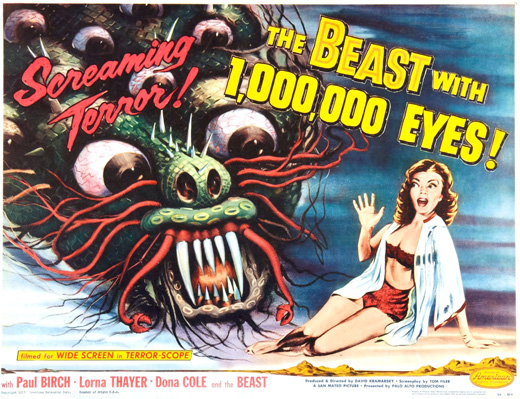 |
Frankenstein and the Wolf Man battle
for the best spot on the poster. |
Some movie monsters are truly immortal. Make-up artist Jack Pierce’s Frankenstein, with his flat head, staples on the forehead, and electrodes sprouting out of the neck, is firmly embedded in the popular collective mind as the definitive monster. Pierce’s Wolf-man and Mummy are not far behind in terms of being instantly identifiable, even to kids who have never seen a classic Universal monster movie (and wouldn’t watch a black-and-white movie if you put a gun to their heads).
Similarly, the original
King Kong was one of cinema’s first blockbuster hits in 1933, becoming so popular that the film was re-released multiple times in the ‘40s, ‘50s and ‘60s. Along the way, Kong has inspired more than a few re-makes and spin-offs, with yet another -- a re-make of a spin-off,
Godzilla vs. King Kong -- scheduled to be released in 2020. Pretty good for a stop-motion model!
 |
If you leave King Kong off the poster, you
can expect to hear from his agent! |
Of course, not all monster makers of the pre-digital era had the resources or the talent of a Jack Pierce or
Willis O’Brien. Before
Star Wars and
The Exorcist made sci-fi and horror into big business, these types of genre films more often than not scraped the bottom of the budget barrel. Effects artists like
Paul Blaisdell and
Jack Rabin made memorable creatures on next-to-nothing budgets (see my earlier post on “
How to Make a Monster: Low-budget Creature Effects"), but it’s difficult to make a monster for the ages when your budget can barely cover the cost of a catered lunch on a mainstream production.
The burden of bare-bones budgets, rushed schedules, and harried effects artists often resulted in monsters that elicited guffaws and flying popcorn boxes instead of gasps and screams. These cases presented problems for the marketing department. If you had any faith whatsoever in your monster, you plastered it front and center in your ads and posters. But occasionally, the marketers had to keep the bargain-basement creature off the artwork (or artfully concealed) if they wanted to have any chance of luring suckers (er, uh customers) to the theater.
Without further ado, here is a sampling of B-movie posters that cleverly concealed their film’s disappointing (if not downright laughable) monster. If you have other examples, please don’t hesitate to alert me via the comment form below, and I can collect them for a follow-up post.
Added bonus: Making its debut on this blog is the incredible new technology,
Reveal-O-Rama! If you dare, click on the poster image to reveal the monster that the marketing dept. took great pains to conceal!
 |
| Movie-goers expecting to see a cool, multi-eyed Chinese dragon-like creature were surely disappointed by this early Roger Corman quickie. Click on the poster to reveal the true beast! |
 |
| In another example of egregious Roger Corman trickery, the poster promised a giant sea monster, and the movie delivered a laughable faux-creature seemingly made out of seaweed and assorted household items. |
|
 |
| With Boris Karloff leading the cast and a classic-looking monster featured on the poster, what could go wrong? Let's just say the monster was more than several steps down from the good ol' Universal days. |
 |
| The poster art wisely left the creature's head out of the frame. Producer Sam Katzman farmed out his creature to a cut-rate effects shop, and the result was a classic of unintentional comedy. |
 |
| The movie featured a great cast headed up by Peter Cushing, and was directed by the talented Terrence Fisher. The silicate monsters, however, looked more like something disgusting you'd wipe off your shoes than a terrifying menace. |
|
 |
| No, this is not the scary, child-eating clown of Stephen King fame. This particular It looks more like a refugee from an old wood pile than an indestructible monster. |
 |
| This poster has it all: sex, blood and rockin' rodent tails (okay, so shrews aren't rodents -- play along with me here). The only thing the shrews in this movie look like they could kill off is a bowl of kibble. |
 |
| I suspect the filmmakers were cynically gambling that few movie-goers would know what "lepus" meant. This is possibly the least scary monster movie concept of all-time. |
 |
| This is based on a story by H.P. Lovecraft and August Derleth. The climactic reveal of the thing in the shuttered room is distinctly un-Lovecraftian and underwhelming. |
 |
| Not even William Castle's "startling" Percepto gimmick could keep audiences from snickering as they saw a thing that looked like a rubber dog-toy being dragged around by a visible "hidden" wire. |














I admit there was no truth in advertising, but two of my most beloved horror movies are here, Night of the Lepus and The Tingler. Although I spent most of Night of the Lepus feeling sorry for Janet Leigh having to appear in it. My favorite line of hers, while consoling a victim: "It's gone. The rabbit's gone."
ReplyDeleteWith so many remakes and plans for remakes floating around Hollywood, I wouldn't be surprised to hear about a do-over of Night of the Lepus, because, you know, they can make those rascally rabbits so much more frightening with CGI now. :)
DeleteThanks for using Reveal-O-Rama. It worked really well, and made everything that much funnier. It's such a good gimmick that it was extremely fitting to end up with a William Castle film.
ReplyDelete